Learning from the Source: (Dis)ability History
This primary source set is targeted to elementary students and includes background information and thinking prompts. It was curated mainly by Dr. John Bickford, Professor of Social Studies/History Education at Eastern Illinois University and Editor-in-Chief of The Councilor: A Journal of the Social Studies.
Access the unit plan that utilizes this primary source set.
Click each source to view it larger.
Primary Source 1
Pre-reading: This is a button. It has a short message.
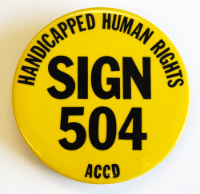
Thinking prompts: (1) What words do you understand? (2) What words do you not understand? (3) Why do you think the button creator used these colors?
Primary Source 2
Pre-reading: This is a bumper sticker. It has a short message with images and colors for emphasis.
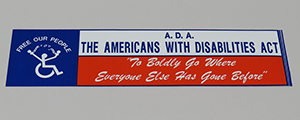
Thinking prompts: (1) What words do you understand? (2) What words do you not understand? (3) What message is sent with the image? (4) What message is sent with the colors?
Primary Source 3
Pre-reading: Jesse Jackson is a politician, a religious leader, and a civil rights advocate.
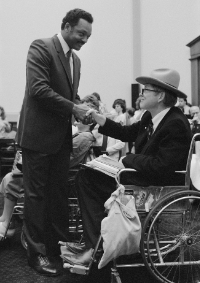
Thinking prompts: (1) What do you learn from this photo? (2) What do you learn from the source title?
Primary Source 4
Pre-reading: This photo shows a demonstration for Medicare and Medicaid, which are programs that help people without much money pay for medicine and medical treatment. The source record mentions a “trojan horse”, which was a huge, hollow wooden horse that the Greeks were thought to have used to secretly get soldiers into Troy during the Trojan War.
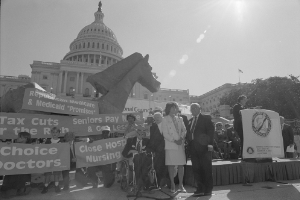
Thinking prompts: Look at this photo carefully. (1) What details do you notice? (2) What do you learn from the text? (3) Why do you think the demonstrators brought along a “trojan horse”?
Primary Source 5
Pre-reading: The White House is where the United States President lives and works.
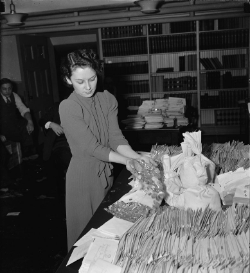
Thinking prompts: (1) What do you learn from this photo? (2) What do you learn from the source title? (clue: infantile = child)
Primary Source 6
Pre-reading: Franklin D. Roosevelt was elected U.S. president four times, serving from 1933 to 1945. (Note: Today, U.S. presidents can only be elected two times in a row). In 1921, when he was 39 and 12 years before he became president he was struck by polio, a disease previously called infantile paralysis because it mainly affected children. Because of this disease, President Roosevelt used a wheelchair, and other assistive devices, but often kept these hidden from view.

Thinking prompts: (1) What details do you notice in the photo? (2) Why do you think the statue creator chose to show President Franklin this way? (3) What do you feel when looking at this source? (4) What questions do you have?
Primary Source 7
Pre-reading: Franklin Roosevelt started his career in politics in 1910. He served as Assistant Director of the Navy during World War I. His wife, Eleanor Roosevelt, worked alongside of him during his career. This text is from Eleanor and Franklin (pp. 267-68), a 1971 book written by her secretary Joseph P. Lash.
“[Eleanor Roosevelt] visited the [Naval Hospital] wards daily, bringing flowers and giving words of cheer. ‘I am taking two ladies from the Navy Department Red Cross Auxiliary to St. Elizabeth’s [Hospital] this p.m.,’ [Eleanor] wrote [her mother-in-law in March, 1919]. ‘We have 400 men in the insane asylum there and the Chaplain asked that we go to see the Doctor in charge and find out what could be done for them as very few organizations take any interest in them and many of the men are not insane but shell shock patients.’ The chief doctor took them through the two naval wards, and pity filled Eleanor’s heart. St. Elizabeth’s, a federal hospital, was starved for funds, short of attendants, lacking equipment. The men were locked in and moved restlessly around their cage-like porches; they were not permitted to go outside for exercise or sports. Eleanor told the doctor that the Navy Red Cross would supply newspapers, games, a phonograph, and records for a Navy recreation room that the Red Cross would build. … [She] asked why the government should not improve the whole hospital… She wanted [Interior Department head, Franklin] Lane to visit St. Elizabeth’s to see conditions for himself, and although he declined, he appointed a departmental investigatory commission, whose report to the House Committee on Appropriations confirmed the inadequacy of the care provided at St. Elizabeth’s. A larger appropriation was voted and the doctors were able to transform the hospital into a model institution.”
Thinking prompts: (1) What problems were the soldiers suffering from? (2) What did Eleanor Roosevelt want to do to help them? (3) What did she help accomplish? (4) What questions do you have?
Primary Source 8
Pre-reading: Anne Sullivan was Helen Keller’s teacher. If you don’t know who Helen Keller was, find out here. This is a photograph of a letter written by Ms. Sullivan to Alexander Graham Bell. If you don’t know who Alexander Graham Bell was, find out here.
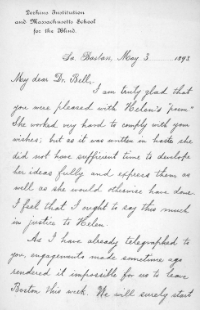
Thinking prompts: (1) How long ago was this letter written? (2) What do you learn about these three people from this source?
Primary Source 9
Pre-reading: A telegram is short message, like a modern text. It is written using short, non-sentences.

Thinking prompts: (1) Who was the message sent to and who wrote it? (2) Why was it written? (3) What do you learn about these people from this source?
Primary Source 10
Pre-reading: Ruth Sienkiewicz-Mercer was a severely disabled woman who fought for disability rights. She struggled with moving and communicating, but not thinking. Read about a moment when she surprised people where she lived from, I Raise My Eyes to Say Yes (pp. 108-09), a 1989 book she wrote with Steven B. Kaplan.
“All of the new attendants [at my assisted living institution] liked to joke around with each other while they were on the job. Everybody enjoyed…[making fun of a bullying, scary boss nicknamed the] Witch, usually when she was out of hearing range. One afternoon…I overheard Wessie wisecracking to Alice about the Witch and I [laughed loudly]. Lately I had come to dislike the Witch intensely, and it felt great to laugh at her expense. But my laughter startled Wessie and Alice, for they didn’t think that I…[could understand] their sarcastic humor. You should have seen the astonished expressions on their faces! First they looked at each other, then they looked at me, then they asked each other whether I could possibly be laughing at what they had said. This prompted me to gesture excitedly with facial expressions and sounds, to tell them, ‘Yes indeed, I was laughing at your joke.’ Then one of them asked me directly if I had been laughing at their remark about the Witch. After some additional raising of my eyes, I convinced them…”
Thinking prompts: (1) What did you learn from this source? (2) What do you feel after reading this source? (3) Write a quick message to the source creator to tell her what you think about her experience.
Primary Source 11
Pre-reading: Alan Brightman is an educator and disability rights advocate. In this text from his 1984 book, Ordinary Moments: The Disabled Experience (p. 105), he shares a memory of participating in a demonstration.
“Protestors using wheelchairs found they were not arrested because local jails were inaccessible. A deaf man leading a rally in front of the White House pretended to not understand the policemen who were asking to see his parade permit. The policemen walked away in frustration, unaware that the deaf man was a skilled lipreader and that there were interpreters present to facilitate communication. These examples begin to suggest both the flavor and the effectiveness of the advocacy strategies I most enjoy. Indeed, the basic principle of acting outside of an adversary’s experience still works for us… My concerns with the issues of disability rights spurred me to get further involved in political action. I learned everything I could about our legal rights… Soon I was conducting workshops… from Maine to Virginia. Up and down the East Coast, I was connecting with disabled peers… Being involved in the disability rights movement has so far been the highlight of my career.”
Thinking prompts: (1) What tactics, or actions, did disabled demonstrators use during the protest? (2) What do you think of these? Do you support the use of these actions? Why or why not? (3) Briefly describe something you have done to stand up for a cause you believe in.
Related resources
Teaching Now: Learning About (Dis)ability in History- An Inquiry for Elementary Students unit plan
